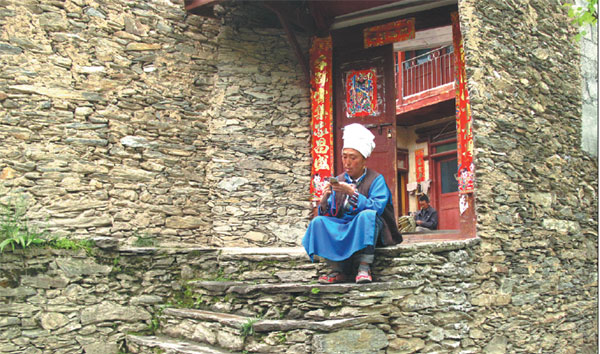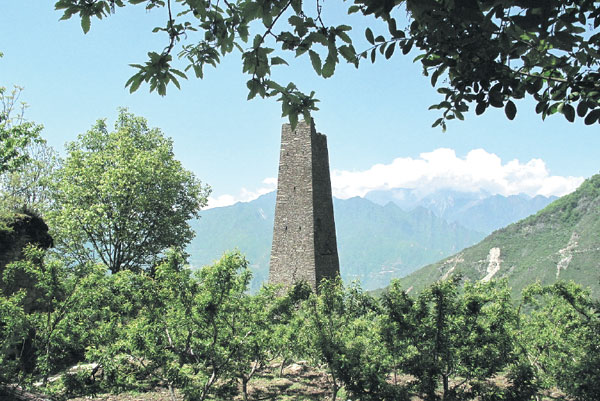A tale of three qiang villages
Updated: 2016-06-09 07:48
By Li Yang in Aba(China Daily)
|
||||||||
The rocky mountain area in the east of the Aba Tibet and Qiang autonomous prefecture, in West China's Sichuan province, which is located between the Qinghai-Tibet Plateau and the Sichuan Basin, has been a crossroads for trade and civilization for about 3,000 years.
During this period, the interaction between Tibetans, Manchurians, Mongolians, Muslims, the Han and the Qiang people - violent and peaceful at various times - has left us with hundreds of villages of historical interest and picturesque scenery, on high mountains, deep valleys, and along the tributaries of the Yangtze River.
After the Manchurian-dominated Qing Dynasty (1644-1911), Tibetans and the Qiang people became the main residents of the Aba region, roughly as big as Scotland.
The two ethnic groups, now comprising more than 800,000 people, account for about 80 percent of the prefecture's population.
"It is a pity that we have almost lost our mother tongue," says Yu Zhengqing, 74, a Qiang farmer in Dasi, the Qiang village in Aba, who cannot speak the Qiang language.
But he can sing old songs in the language.
Speaking, after a boisterous Qiang dancing and singing performance to greet tourists at the entrance of his village, he adds: "We are also losing Qiangdiao," referring to a kind of ancient tower built exclusively by the Qiang people using rocks, mud and wood.
The Qiang people are known as talented builders who can build sturdy dams, houses and fortifications with natural materials.
Isabella Bird, a 19th-century English explorer, writer and naturalist, who was the first woman to be elected a Fellow of the Royal Geographical Society, used to visit Aba and wrote about Qiangdiao in her book published in 1899 called The Yangtze Valley and Beyond, saying the castle-like towers added liveliness to the endless mountains.
The village used to have 14 Qiangdiao towers, which were built over a period of 500 years.
They were located at carefully chosen spots in and around the 300-home community, to ensure every inch of the vicinity was within an arrow's range and was under the surveillance of the sentries on the towers.
But there is only one tower left today. The rest were demolished during the 1950s or destroyed in the 2008 Wenchuan earthquake.
Speaking of the Qiangdiao, while standing at the foot of the only remaining tower, Peng Zhao, the Party chief of Keku town, to which Dasi village belongs, says: "Few people would build these things today. They are useless in a gun era."
But, Peng and his colleagues pay special attention to protecting the old Qiangdiao in Keku, because "they see it as a symbol of Qiang architecture and, more importantly, a tourist attraction".
Echoing this view, Yang Zhiwen, a successful businessman and village committee director, who returned home in 2006 after having gone to work in Chengdu, the provincial capital of Sichuan, at 16, says: "The loss of Qiang culture is disturbing. "I have seen villagers selling cultural relics unearthed from ancient tombs, and I feel my hometown is being hollowed."
Yang, who says he built a Qiang ethnic culture museum in Dasi as a tourist attraction, now contracts villagers' lands and employs them to plant plum, blueberry and herbs instead of potatoes and corn which they used to grow earlier.
The annual income of the villagers has grown from 500 yuan ($77) in 2008 to 10,000 yuan last year, thanks to tourism and agriculture.
"The villagers now see the value of their unique culture and the advantage of the well-preserved environment on the high mountains," says Yang.
"Also, 10 years after returning to the village, it is now much easier to organize fellow villagers to revive old arts like making clothes, embroidery and doing performances, and to raise their awareness about protecting the Qiangdiao.
Luo Jinyong, director of the Hanchuan Museum in Aba and a Qiang culture expert, says: "When compared with the government cultural protection project, the Dasi model is more sustainable and effective.
"The Qiang have the same ancestors as the Han, who later became the largest ethnic group in China.
"So, for most Han tourists, visiting an ancient Qiang village is like calling on their ancestral brothers, who have maintained some semblance of an ancient lifestyle."
The Qiang believe that everything in nature has a soul. They worship white quartz stones and place the snow-white stones on their houses to protect the family.
Luo says there are two explanations for the white-stone worship - one is that their ancestors made fire using it; and the other is that the ethnic group won a life-and-death struggle with it when the enemy mistook the white stone for snowballs.
A three-hour drive from Dasi along a meandering mountain path will take you to three Qiang villages in neighboring counties. A'er, one of the villages, is known for its traditional stunts.
Zhu Guangliang, an 81-year-old tribal chief in A'er, can pierce both his cheeks with a long steel needle, without bleeding.
Some villagers can lick or walk with bare feet over red-hot iron bars without hurting themselves.
Speaking of these stunts, Zhu says: "These things were regarded as superstition during the cultural revolution (1966-76), and nobody wanted to learn how to do them.
"But now they (these stunts) are very popular with tourists, and the government protects them."
Taoping Qiang village in neighboring Lixian county was one of the first spots to be developed by the government in late 1990s as a tourist attraction. and is known as "a living Qiang architecture museum".
The 98 houses in the village perched on a mountain slope above a river are connected through a roof, a water supply network and corridors.
The village was built over a period of about 100 years, and looks like a castle from across the river.
The people living there have rules on how the water is to be used. For example, there is a time in the day to wash vegetables and a time to wash clothes.
The Yang Family Residence in the center of Taoping is the largest one in the village. It has dozens of rooms spread over three floors. The good-quality wood used instead of rock in the construction of the house shows the wealth of the family.
Also, the fact that the Yang family can adjust the water flow that comes through the underground water network below the residence - something the other families in the village cannot do - indicates the family's status in the community, says Yang Dengfu, 60, owner of the house. But Yang is nor very aware of his ancestors' history.
The remote Zengtou Qiang village is an exception when it comes to education.
The mountain village has produced a number of scholars and senior-level civil servants in its 3,000-year history.
In its current avatar, the dilapidated old village comprises 90 houses on the mountain, but there is also a new village of about 150 homes down the mountain.
There used to be four large temples and many stone tablets in the village. But most of them were destroyed in the 1960s and 1970s.
Guocheng, the former Party chief of Zengtou, who is now in his late 70s, attributes the village's educational success to its fengshui and the protection of various gods from the mountain, river and heaven.
"The village is old. But I am still very young," he says.
Now, Zhou hopes the village can attract more tourists, so that the young villagers understand that the past has value for their future.
Contact the writer at liyang@chinadaily.com.cn
liyang@chinadaily.com.cn
|
A Qiang woman makes shoes in her courtyard while her husband weaves a bamboo basket in Heihu Qiang village in Aba. Li Yang / China Daily |
|
The last qiangdiao fortification tower in Dasi village in the Aba Tibetan and Qiang autonomous prefecture, Sichuan province, survived a 7.8-magnitude earthquake in 2008. Li Yang / China Daily |
(China Daily 06/09/2016 page10)
- Suspected IS terrorists arrested in Germany
- Japanese boy abandoned by parents in Hokkaido forest found alive
- China to build Africa's biggest university library
- 'Kill list' found in UCLA campus shooter's residence: Police
- Swiss declare Alps tamed as Gotthard rail tunnel opens
- China urges Japan to properly settle Chinese forced laborers issue

 Euro powers land in France for UEFA EURO 2016
Euro powers land in France for UEFA EURO 2016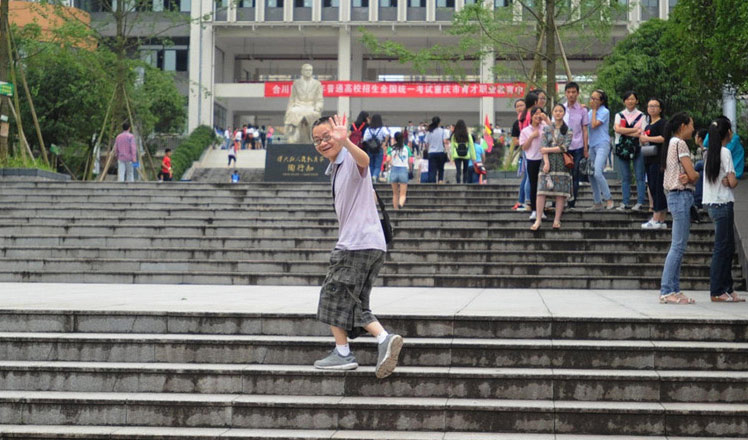
 The most unusualgaokao candidates in 2016
The most unusualgaokao candidates in 2016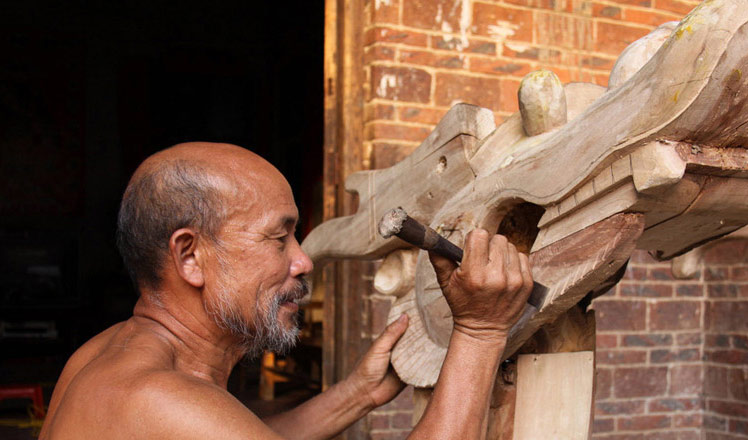
 Elderly man carries on 1000-year old dragon boat craft
Elderly man carries on 1000-year old dragon boat craft
 Row your dragon boat, cute pandas in Yunnan!
Row your dragon boat, cute pandas in Yunnan!
 In pics: China's college entrance exam starts
In pics: China's college entrance exam starts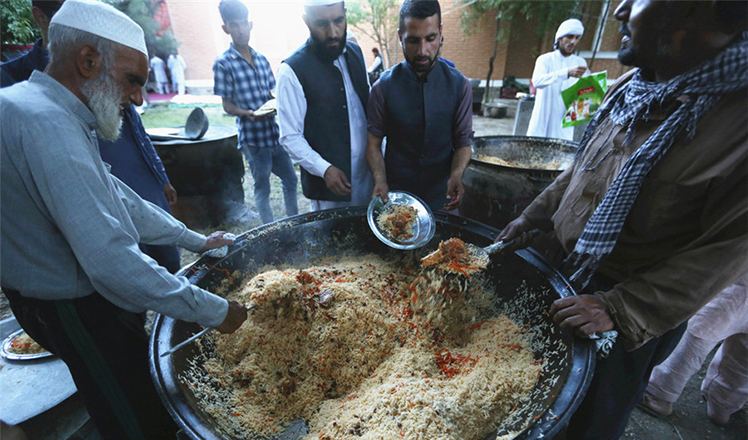
 Popular foods to break fast during holy month of Ramadan
Popular foods to break fast during holy month of Ramadan
 Top 10 biggest brands in Asia listed in media report
Top 10 biggest brands in Asia listed in media report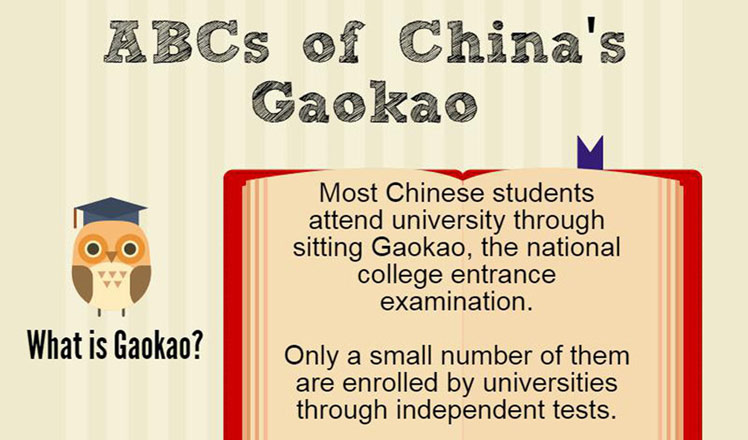
 Things you need to know about China's gaokao
Things you need to know about China's gaokao
Most Viewed
Editor's Picks

|

|

|

|

|

|
Today's Top News
Abe's blame game reveals his policies failing to get results
Ending wildlife trafficking must be policy priority in Asia
Effects of supply-side reform take time to be seen
Chinese State Councilor Yang Jiechi to meet Kerry
Chinese stocks surge on back of MSCI rumors
Liang avoids jail in shooting death
China's finance minister addresses ratings downgrade
Duke alumni visit Chinese Embassy
US Weekly

|

|
